众所周知,加拿大是世界上面积第二大的国家,国土辽阔,资源丰富,地广人稀。除了高度发达的科技和生活品质,加拿大的艺术历史源远流长,尤其在视觉艺术上闻名世界,众多学校成为艺术学子梦寐以求的dream school。
相较于英美,加拿大留学最大的优势就是容易移民。除此之外,加拿大留学和生活的费用相对英美较低,学校的招生政策和录取条件相对英美较为容易,而且加拿大政府对教育的重视程度使得加拿大的高等教育体系和教育水平丝毫不逊色与英美,教学环境,实践机会,资源平台,生活条件丝毫不落后于英美,并且加拿大政府在2017年官方新政策中大力鼓励留学移民,相信2017年将成为国际学子纷纷奔赴加拿大求学的旺季。
大部分学习艺术的学子大都想要进入加拿大的四大独立美院,分别是安大略艺术设计学院 ( OCAD - Ontario College of Art and Design ),诺瓦艺术设计大学 ( NSCAD – Nova Scotia College of Art and Design ),艾米丽卡艺术设计学院( ECUAD – Emily Carr University Art and Design ),阿尔伯塔艺术设计学院 ( ACAD – Alberta College Art and Design ),今天详细为大家介绍这四所学校的专业设置以及申请条件。
(一)安大略艺术设计学院 ( OCAD - Ontario College of Art and Design )
学校简介:OCAD 是一所公立大学,坐落于加拿大安大略多伦多市,由加拿大艺术家协会于1876年创办,拥有鼓舞人心的艺术资产和成熟的师资队伍,是加拿大历史最悠久,规模最大的艺术与设计院校,长居北美同类型大学TOP前3名,100多年以来培养出了大量的艺术家和设计师,被誉为加拿大的 “想象大学”。
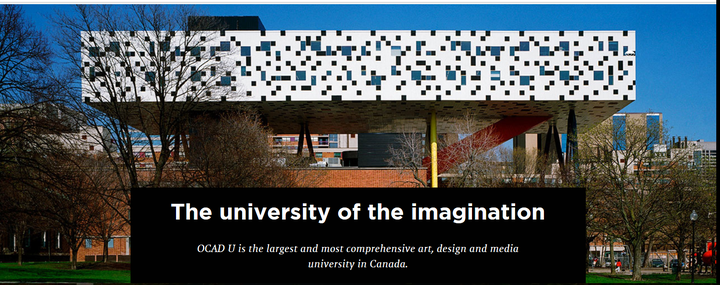
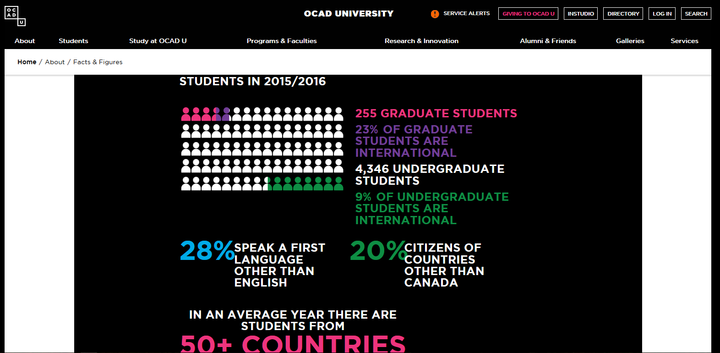
1.本科专业设置与学位设置:
BA(Honor) :视觉与批判研究。
BA&BFA:本土视觉文化,数码化未来,批判与评论实践,跨学科艺术—生活研究,跨学科艺术出版物,摄影,雕塑/装置,版画,绘画/油画,绘画/油画—数字绘画与展开动画,多媒体,多媒体—数字绘画与展开动画。
BD:广告,环境设计,室内设计,平面设计,插画,工业设计,材料艺术与设计。

GPA》70分
托福 72分(听14 说19 读 15 写18)
or雅思6.0分(听5 说5 读 5 写5.5)
orCAEL60分(听 50 说 50 读 50 写 55)
orCOPE80分(听 20 说 5 读 20 写 30)
350字左右的Creative profile
作品集 Portfolio
申请视觉与批判研究本科只需500字左右Original writing sample on an assigned topic
申请digital futures 需额外提交an evaluation of a digital product, software or service
不同年级所需作品集要求不同,申请高年级入学还需额外提供350字作品集创作目的说明。
3.作品集准备建议:
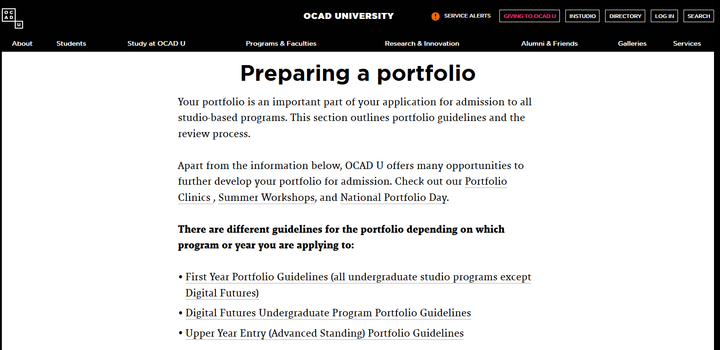
Include a maximum of 10 pieces of your original work in art, design or media, including a creative journal/sketchbook to demonstrate your creative process
Demonstrate your ability to work with a wide range of techniques, materials and subject matter
Include works in 2D, 3D, time-based, lens-based, digital or traditional media
Originals are preferred, if you are presenting your portfolio in-person. If you can carry the work easily you can include it in your portfolio. If the work is too large to transport, is very fragile, or for site specific work, you may present the piece as a digital image or photograph. There are no other size limitations
Whenever possible applicants are strongly encouraged to provide their own laptop for the review of digital or time-based work for the in-person assessments. A limited number of laptops will be available during the reviews
Drawings may be from direct observation, such as figure drawing, still life, interiors and landscapes, as well as from imagination and memory
Please present work flat rather than rolled, mounted or framed.
Work exploring colour, form and mixed media approaches are welcome, as are three dimensional works, such as installations, models, jewellery, soft or hard sculpture
Feel free to include work that directly relates to the discipline that you are applying to
(2) 本科第一年digital futures :
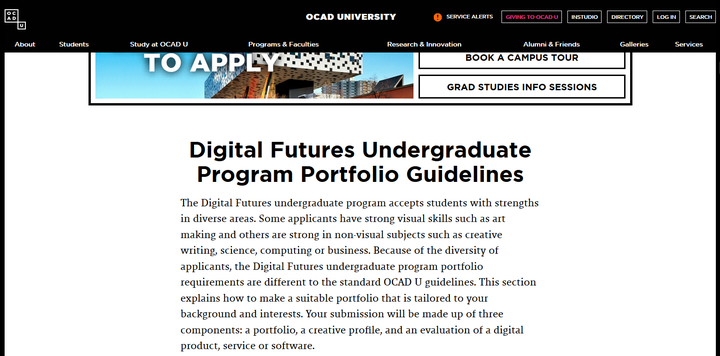
Your portfolio is an important part of your admission application. Keep in mind that when it comes to your portfolio, the most important features we look for are passion and curiosity — along with your ability to think laterally or "outside the box." This can be shown through visual or non-visual work. You can include a maximum of 10 pieces of work, one of which will be your sketchbook/creative journal/process document etc.
If your strengths are predominantly visual: your portfolio needs to demonstrate a variety of your skills and approaches to art making. This can include experimentation in both traditional and digital media, shown in a diverse range of media. Work exploring colour, form and mixed media approaches are welcome, as are three dimensional works, such as models, jewellery or sculpture. You can also provide links to websites that you have designed or that contain your work.
If your strengths are predominantly non-visual: your portfolio should include your best project work from subjects, such as reports or extensive written work. You should also add any hobbies or interests that give us an indication of your passion and curiosity. Some examples include photography, craft, poetry, cartoons, homemade videos, model making, computer programs, Facebook or other websites.
If your strengths are both visual and non-visual: you can follow both sets of the guidelines given above.
额外要求——Evaluation Piece
An evaluation of a digital product, software or service is also a required element of the portfolio. Choose something that you consider to be truly exceptional or special to you and work out how it could be dramatically improved and impress us with your thinking. Just a few examples include an iPod, Amazon website, game console, car navigator, even Microsoft Word.
Your evaluation must be no more than two pages long. You may include:
Photographs, diagrams, sketches and drawings
An explanation of why the choice is special to you
What could be improved for now and for the distant future.
(3) 本科高年级作品集准备建议:
需要额外提交350字左右的作品集创作目的的说明,此外申请大二入学需要提供与等大一的学习证明,申请大三入学则需提供大一大二两年的学习证明,分为art,disign及digital futures 三个方向的作品集准备建议。
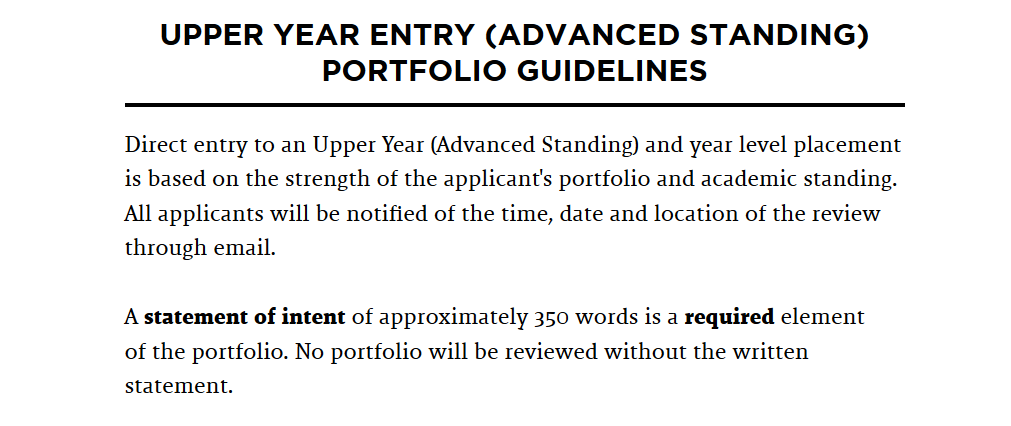

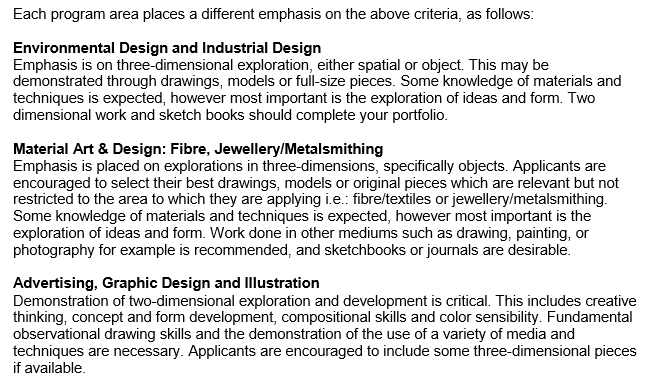
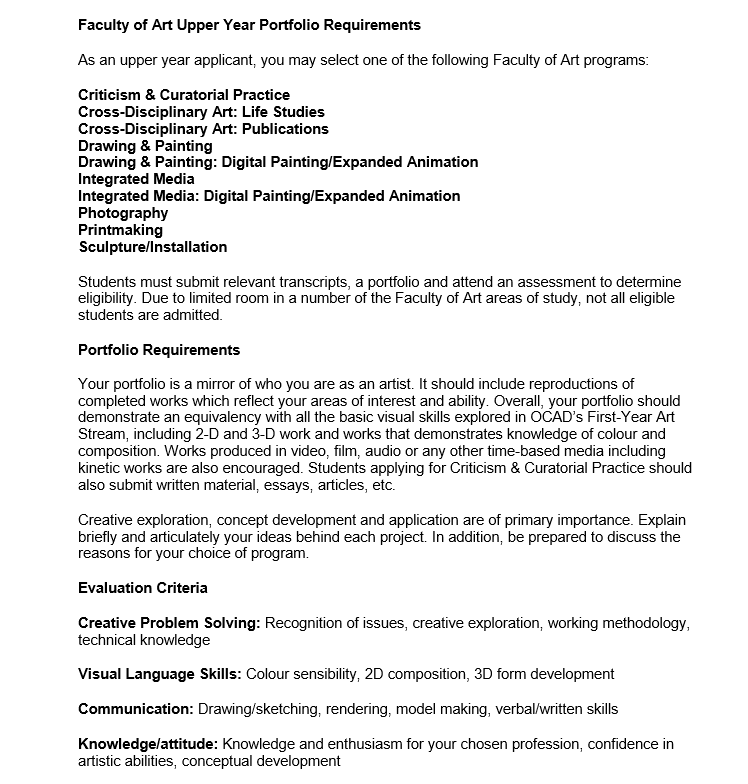

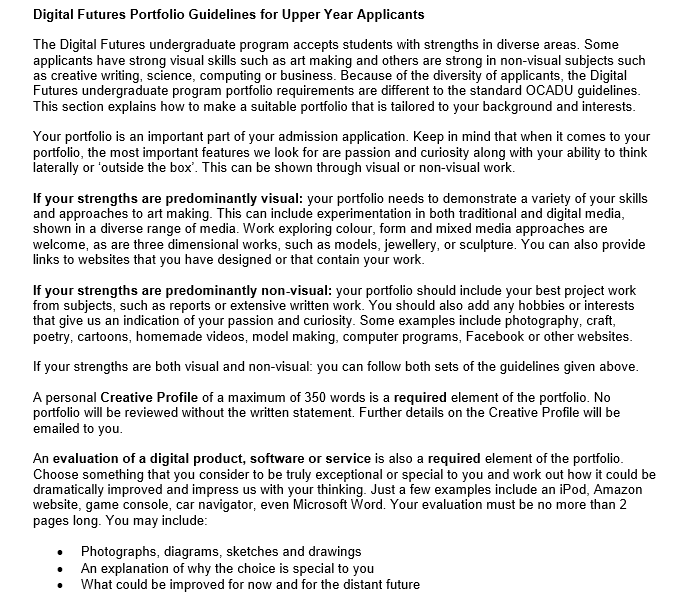
Portfolio preparation tips:
• Include a maximum of10 pieces of your original work, including if possible a journal/sketchbook to demonstrate your creative process • Demonstrate your ability to work with a wide range of techniques, materials and subject matter • Include works in 2D, 3D, film, digital or printed media • Originals are preferred. If you can carry the work easily you can include it in your portfolio. • If the work is too large to transport, is very fragile, or for site specific work, you may present the piece as a digital image or photograph. There are no other size limitations
• Whenever possible applicants are strongly encouraged to provide their own laptop for the review of digital or time-based work. A limited number of laptops, TV's and DVD players will be available during the reviews • Drawings may be from direct observation, such as figure drawing, still life, interiors and landscapes, as well as from imagination and memory • Please present work flat rather than rolled, mounted or framed.
Tips for your presentation:
• Generate interest and excitement with the first piece of work • Be aware that current work best demonstrates your skill level • Be prepared to explain why a particular work was selected for inclusion in your portfolio, what it means to you and what you were trying to achieve • Be prepared to talk about any research and preparation you did for your final work • Research the Digital Futures undergraduate program ahead of time to show your level of interest and commitment to studying here
4.研究生专业设置及学位设置:
(1)当代艺术,设计与新媒体艺术史(MA) ,(2)批判与评论实践(MFA)
(3)健康设计(MD) 、(4) 包含设计,(5)战略性预知与创新(MD)
(6)数码化未来(MA,MD and MFA),(7)艺术,媒体与设计(MA,MD&MFA)

GPA》80分
托福90分 ( 22 Reading, 20 Listening, 22 Writing, 22 Speaking)
雅思7分 (小分不少于7)
Application for admission into the MA in Contemporary Art, Design and New Media Art Histories is competitive. Applicants must hold a BA, BFA, BDes, or comparable honours degree/certification with an average of 75 per cent (B+) or better during the last two years of study, or must demonstrate exceptional related experience/expertise as a practising art or design professional. All applicants must demonstrate creative and conceptual competence at a high level.
If the application deadline has passed, an expression of interest in the Contemporary Art, Design and New Media Art Histories graduate program may be considered. Please email us at gradstudies@ocadu.ca for further details.
For consideration by the admissions committee, and in addition to the basic application requirements outlined below, applicants need to complete and submit the following through SlideRoom:
Research Proposal: Maximum 250 words that clearly outlines your background and describes your research interests; bibliography and illustrations may be included.
Writing Sample: Not more than 20 pages, which can be in published or manuscript form; if manuscript, the text must be typed and the context in which it was produced identified.
CV: Applicants should include an updated copy of their curriculum vitae.
Application for admission into the MFA in Criticism & Curatorial Practice at OCAD U is a highly competitive process. Applicants must hold a BA, BFA, BDes, or comparable honours degree/certification with an average of 80 per cent (A-) or better during the last two years of study, or must demonstrate exceptional experience/expertise as a practising artist, designer, critic or curator. All applicants must demonstrate creative and conceptual competence at a high level.
For consideration by the admissions committee, and in addition to the basic application requirements outlined below, applicants need to complete and submit the following through SlideRoom:
Research Proposal: Applicants should clearly outline their background in their area of concentration and describe their research interest or theme for their graduate work in the program. The proposal must be typed and should not exceed 500 words. Appendices including bibliography and examples of visual work may be included if appropriate.
CV: Applicants should include an updated copy of their curriculum vitae.
Application for admission into the Master’s in Design for Health will be competitive. Applicants must hold a bachelor degree in a design field, such as BA (in design studies), B.Arch., BED, BID, BDes, BSc, BEng or comparable honours degree/certification with a GPA of 75% (B+) or better during the last two years of study, or must demonstrate exceptional experience and expertise as a practitioner in a relevant discipline. All applicants must demonstrate creative and conceptual competence at a high level, as well as the clear potential for acquiring a sufficient level of expertise in the diverse disciplines relevant to this degree.
A portfolio comprised of 10 examples of design work and a 750-word statement of interest will be required.
For consideration by the admissions committee, and in addition to the basic application requirements outlined above, applicants need to complete and submit the following through SlideRoom:
Statement of Interest: Applicants should describe their key areas of interest in the health sector, detailing how their academic background and professional experience relate to their interests, and how their intended practice and research align with the objectives of the program. The proposal must be typed and approximately 750 words in length. If you are also applying for the AGE-WELL scholarship, please also describe in your Statement of Intent how your experience, expertise, and proposed area of interest/research aligns with AGE-WELL’s Goals and Priorities. AGE-WELL’s vision is to harness and build upon the potential of emerging and advanced technologies to stimulate technological, social, and policy innovation and create technologies and services that benefit older adults and caregivers.
Design Portfolio: Applicants must submit samples of relevant student or professional work produced in the last five years. Visual work, analytic reports, proposal documents etc. may be included. Applicants are expected to demonstrate proficiency in their primary design discipline(s). The applicant’s best work should be represented.
Alternative Portfolio (for non-design applicants): A limited number of candidates with ‘non- design’ qualifications and backgrounds such as engineering, computer science, public health and medicine may be considered for entry on a case-by-case basis, considering criteria such as professional and personal experience within the area of design for health. Requirements for applicants with non-design undergraduate degrees are the same as for design degree graduates, except that the portfolio should focus on providing sufficient documentation of experience relevant to health innovation.
CV: Applicants should include an updated copy of their curriculum vitae.
Applicants must hold a BA, BFA, BDes, BComm, BSc, BEng or comparable honours degree/certification with an average of 75 per cent (B+) or better during the last two years of study, or must demonstrate impressive experience and expertise as a practitioner in a relevant discipline. All applicants must demonstrate creative and conceptual competence at a good level, as well as the clear potential for acquiring a practical knowledge in the diverse disciplines relevant to this graduate program to create an innovative and implementable thesis project.
If the application deadline has passed, an expression of interest in the Digital Futures graduate program may be considered. Please email us at gradstudies@ocadu.ca for further details.
For consideration by the admissions committee, and in addition to the basic application requirements outlined below, applicants need to complete and submit the following through SlideRoom:
Letter of Intent: Applicants should explain their personal philosophy and reasons for applying to this program and refer to any relevant experience, background and future ambitions. The letter must be typed and be 1000 to 1500 words in length.
Research Outline: Applicants must provide an initial proposal for a research project that they are interested in pursuing in the program. This should include: 1) a title, 2) the area of interest and/or idea, 3) the rationale for the research and an explanation of your proposed field of study including any relevant theories and methodologies, 4) expected outcome in terms of innovation and realized creative work, 5) the relevance of the applicant’s background and experience, 6) any reference sources used in the proposal, 7) bibliography of relevant sources. The proposal must be typed and should be 800 to 1,000 words in length.
Samples of Work: Applicants must submit samples of relevant student and/or professional work produced in the last five years. Visual work, analysis reports and proposal documents may be included. Applicants are expected to demonstrate an in-depth understanding of their primary area of interest. Applicants must submit samples of relevant student and/or professional work produced in the last five years.
Academic References: Applicant will be asked to provide exactly 3 references that can speak to your post-secondary performance, capacity for research and potential for academic study at the graduate level.
CV: Applicants should include an updated copy of their curriculum vitae. Short-listed candidates may be invited for an interview. The interview is an ideal opportunity for the candidate to meet with faculty, ask questions about the program and visit studio facilities and labs at OCAD U. Alternate arrangements will be made for applicants who are unable to attend the interview in person.
Note: admission to the degree program is contingent on the availability of an appropriate Principal Advisor in the student’s declared area of research interest.
The application process for admission into the Master of Design in Inclusive Design at OCAD U is highly competitive. Applicants must hold a BA, BDes, BComm, BEng, BSc, BFA or comparable honours degree/certification in a program that provides a foundational grounding in information and communication systems and practices (e.g., Computer Science, Software Engineering, Information Studies, Culture and Technology or similar field) with an average of 75 per cent (B+) or better during the last two years of study, or must demonstrate exceptional experience/expertise as a practitioner in a relevant discipline. All applicants must demonstrate creative, technical and conceptual competence at a high level, as well as the clear potential for acquiring a sufficient level of expertise in the diverse disciplines relevant to this degree to create a truly innovative, germane and implementable project at the master’s level.
If the application deadline has passed, an expression of interest in the Inclusive Design graduate program may be considered. Please email us at gradstudies@ocadu.ca for further details.
For consideration by the admissions committee, and in addition to the basic application requirements outlined below, applicants need to complete and submit the following through SlideRoom:
Statement of Intent: 1,000 words maximum that describes the applicant’s key area of intended research in the program, how their academic background and professional experience relates to the program, and how the intended research aligns with the objectives of the program. Appendices including bibliography may be included.
Samples of Work: Representative samples of relevant student or professional work produced in the last five years. Software, user-experience designs, analysis reports, proposal documents, web applications and websites, may be included.
CV: Applicants should include an updated copy of their curriculum vitae.
Shortlisted candidates may be invited for a teleconference or in-person interview.
Application for admission into the Interdisciplinary Master’s in Art, Media & Design at OCAD U is a highly competitive process. Applicants must hold a BA, BFA, BDes, or comparable honours degree/certification with an average of 80 per cent (A-) or better during the last two years of study, or must demonstrate exceptional experience/expertise as a practicing artist, designer or scholar.
All applicants must demonstrate creative and conceptual competence at a high level, as well as the clear potential for acquiring a sufficient level of expertise in a secondary discipline to create an integrated interdisciplinary thesis project at the Master’s level.
For consideration by the admissions committee, and in addition to the basic application requirements outlined below, applicants need to complete and submit the following through SlideRoom:
Research Proposal: Applicants should clearly outline their background in at least two areas of expertise and describe their interdisciplinary research interests or theme for their graduate work in the program. One of these areas of expertise must be in studio art, media or design. The proposal must be typed and should be a maximum of 500 words. Appendices including bibliography and examples of visual work may be included. It is strongly suggested that applicants identify at least one graduate faculty member they would like to work with during their studies.
Portfolio and Statement: Applicants must submit a maximum of 15 still images representing no more than five bodies of work. Quicktime movies or other time-based image files should not exceed three minutes in length. Applicants are expected to demonstrate an in-depth understanding of their primary area of concentration and are encouraged to submit any examples of interdisciplinary work. The portfolio should represent the applicant’s best work (formally, conceptually, and contextually resolved). A significant number of the images should represent work produced in the last 12 months. The portfolio must be accompanied by an artist/designer statement of no more than 250 words. The statement should speak to recent work and explain its relevance to the research proposal. It is suggested you discuss the discursive vectors of your practice, your existing expertise and how you would like to grow your practice during your graduate studies. A list of the works submitted should also be included in the portfolio.
CV: Applicants should include an updated copy of their curriculum vitae.
Shortlisted candidates may be notified regarding an interview. No original work is to be presented during the interview. The interview is an ideal opportunity for the candidate to meet with graduate faculty and to discuss the program and the candidate's research proposal. Alternative arrangements will be made for applicants who are unable to attend the interview in person.
Application for admission into the Master of Design in Strategic Foresight and Innovation at OCAD U is a competitive process. Applicants must hold a BA, BFA, BDes, BComm, BEng or comparable honours degree/certification with an average of 75 per cent (B+) or better during the last two years of study, or must demonstrate exceptional experience/expertise as a practitioner in a relevant discipline.
All applicants must demonstrate creative and conceptual competence at a high level, as well as the clear potential to create a truly innovative, germane and implementable project at the master’s level. Short-listed candidates will be invited for an interview.
If the application deadline has passed, an expression of interest in the Strategic Foresight and Innovation graduate program may be considered. Please email us at gradstudies@ocadu.ca for further details.
For consideration by the admissions committee, and in addition to the basic application requirements outlined below, applicants need to complete and submit the following through SlideRoom:
Statement of Intent: 800 to 1,000 words that describe significant personal or professional experiences which have shaped the applicant’s goals, how the SFI program can support the applicant in meeting those goals, as well as a brief description of a topic area or challenge for which the applicant would be interested in conducting research, including a rationale for its potential value. A student may change the research topic prior to embarking on his/her major research topic. A bibliography and relevant examples of work may be included. The statement serves to assist us in better understanding the alignment between the objectives of the SFI program and of the applicant.
Samples of Work: Please submit relevant professional and/or student work produced in the last five years. Applicants are encouraged to include the best examples of work that are typical of the variety of work they have done. Diversity in experience in the cv should be evident in the portfolio. Visual work, analysis reports and proposal documents may be included. Applicants are expected to demonstrate an in-depth understanding of their disciplinary/professional work.
CV: Applicants should include an updated copy of their curriculum vitae. Applicants should include information regarding educational achievement, professional practice and community service.
Statement of Intent: 800 to 1,000 words that describe significant personal or professional experiences which have shaped the applicant’s goals, how the SFI program can support the applicant in meeting those goals, as well as a brief description of a topic area or challenge for which the applicant would be interested in conducting research, including a rationale for its potential value. A student may change the research topic prior to embarking on his/her major research topic. A bibliography and relevant examples of work may be included. The statement serves to assist us in better understanding the alignment between the objectives of the SFI program and of the applicant.
Samples of Work: Please submit relevant professional and/or student work produced in the last five years. Applicants are encouraged to include the best examples of work that are typical of the variety of work they have done. Diversity in experience in the cv should be evident in the portfolio. Visual work, analysis reports and proposal documents may be included. Applicants are expected to demonstrate an in-depth understanding of their disciplinary/professional work.
CV: Applicants should include an updated copy of their curriculum vitae. Applicants should include information regarding educational achievement, professional practice and community service.
| 首页 | 立即通话 | 在线咨询 |
